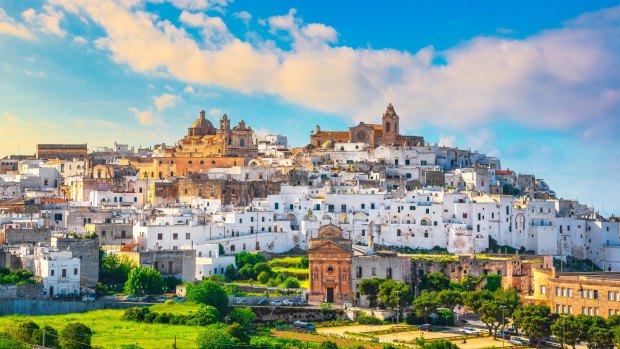ALBEROBELLO
Puglia's tourism superstar exercises a fairytale fascination on account of its trulli – whitewashed houses that sit beneath conical roofs made from limestone slabs, held together as if by magic. A magnet for Instagrammers, the trulli cover an entire hillside, more than 1000 of them lining the laneways that unspool from the Church of Saint Anthony, a kind of trulli on steroids. Helped along by Alberobello's inclusion on UNESCO's World Heritage list, many of its trulli have now become souvenir shops, cafes, galleries and even small hotels where you can spend the night in, truly, very different surroundings. See pugliaandculture.com
PORTO SELVAGGIO

Ostuni, the largest of the so-called "White Cities", looks like a sugar-cube village transplanted from Greece's Cyclades Islands.Credit: Shutterstock
Deep on the Salento Peninsula, the heel of the Italian boot, this shelving limestone cove dominated by a 16th-century watchtower at one end is among Puglia's finest beaches, the siren that lures many Europeans southwards. Porto Selvaggio means "wild harbour" and there is more than a touch of the feral about this rock-strewn bay, serenaded by the rustling wind in the umbrella pines of the national park that overlooks the beach. The bay's rock platforms, so convenient for swimmers, are a legacy of Puglia's pre-Roman Messapian tribes who quarried the limestone for the nearby town of Gallipoli, "Beautiful City" in Greek. See viaggiareinpuglia.it
OSTUNI
Capping a hilltop above gnarled olive trees on the plain below, Ostuni, largest of the so-called "White Cities" of the Itria Valley, looks like a sugar-cube village transplanted from Greece's Cyclades Islands. Once inside, Ostuni is all languid charm, its knotted alleyways curling beneath wrought iron balconies and stone staircases with sleepy cats. Press on to the city's upper storey and you'll find yourself rewarded with spacious piazzas furnished with gothic and baroque churches and cafes strategically placed by fountains. Better still, book in for a couple of nights at La Sommita, a cruisy tribute to good living in a repurposed 16th-century palace. See pugliaandculture.com
LECCE
While most of Puglia subsisted in a state of scraping poverty, Lecce took the high road. A major settlement since Roman times, the soft, honey-coloured Lecce limestone quarried nearby was both the source of its prosperity and its preferred building material, perfectly suited to the giddy extravagance of the baroque that earned Lecce the subtitle "Florence of the South". The streets radiating from the main piazza are lined with churches and classical facades festooned with cherubs and grapes. Don't miss the Faggiano Museum, an archaeological treasure trove with exhibits dating back 25 centuries, discovered when a local restaurant owner dug down to investigate a blocked toilet. See pugliaandculture.com
MASSERIE
A masseria is a traditional farmhouse of the region, once the centre of a substantial estate that would usually have included olive trees, orchards and pastures. Today, many masserie have been taken over by enlightened urbanites who recognised a diamond in the rough, called in smart architects and interior designers, installed swimming pools and chefs awake to the possibilities of regional cuisine and opened the front door. What guests experience at a masseria is relaxation and calm coupled with a powerful sense of country life in Puglia, ideal for anyone who wants to plumb the soul of the region. See charmingpuglia.com
POLIGNANO A MARE
At heart, Polignano is just a seaside village yet its position, teetering on the brink of cliffs that run a lasso around a sea cove, elevates it to the miraculous. The old town is a compact medieval quarter made for the evening passeggiata, the aimless evening walk that precedes dinner in every Italian town. Polignano is a perfect place to sample the seafood for which Puglia is famous, the refined Specchia Sant'Oronzo (specchiasantoronzo.it) if you're feeling flush, Grotta Ardito (ristorantegrottardito.it) if not. Don't be surprised if they play Volare, the singer/songwriter Domenico Modugno, who wrote it, was born here. See pugliaandculture.com
Michael Gebicki travelled at his own expense.
Sign up for the Traveller Deals newsletter
Get exclusive travel deals delivered straight to your inbox. Sign up now.